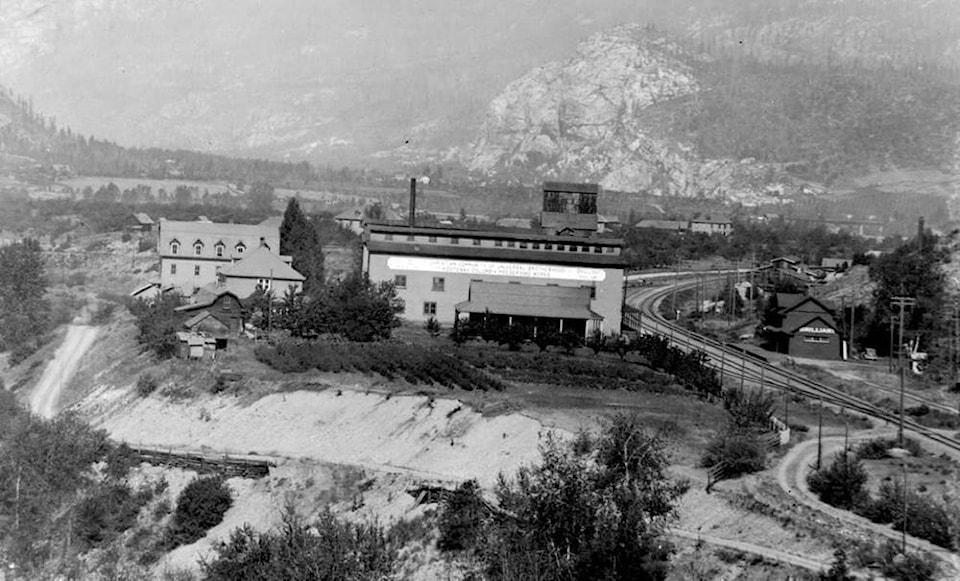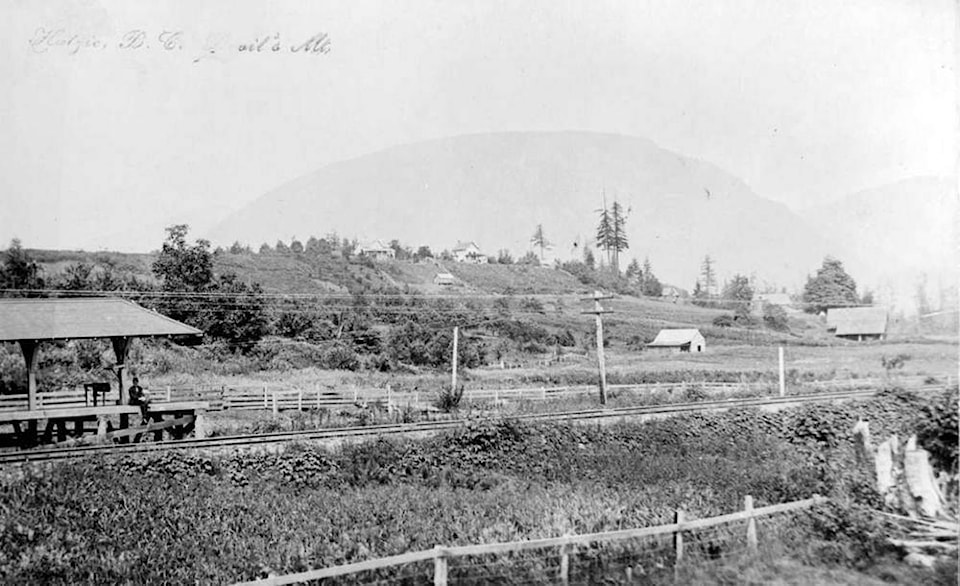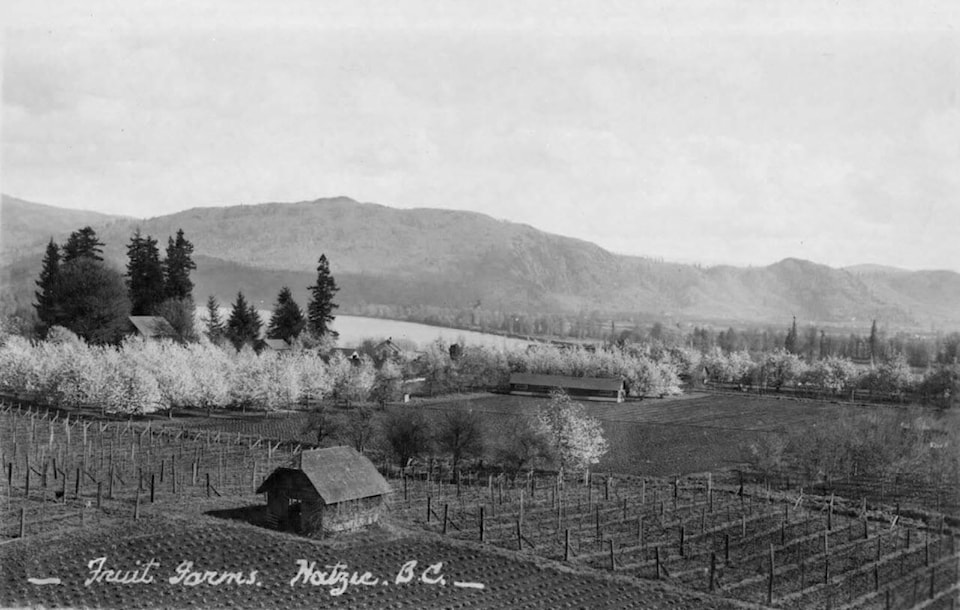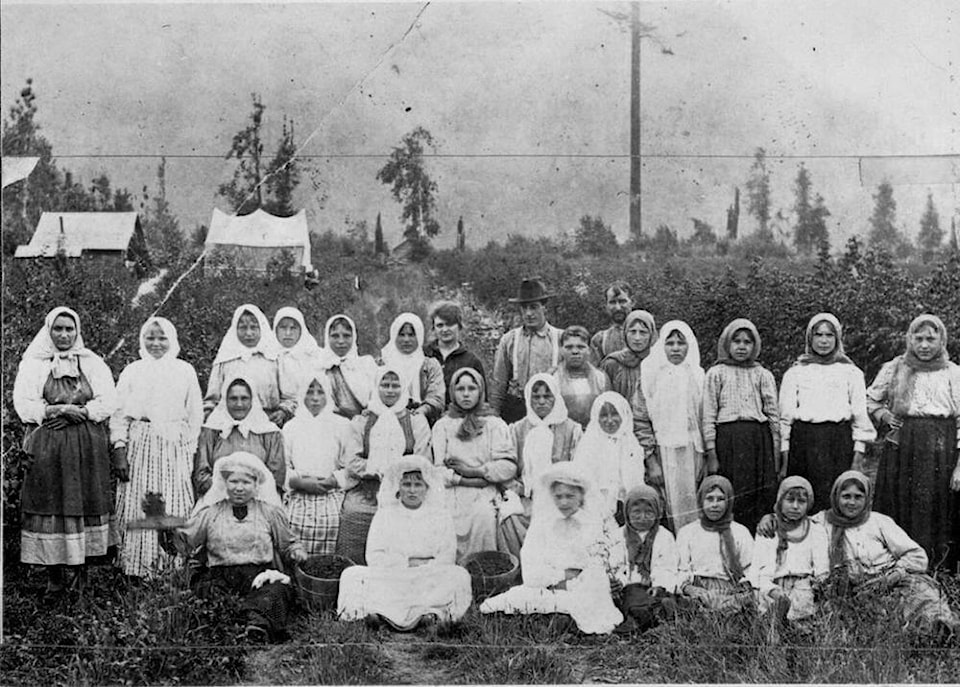by Jonathan J. Kalmakoff
Special to the Record
In the summer of 1918, 150 Doukhobor young women from Brilliant disembarked at Hatzic, 350 miles away in the Lower Mainland of BC, to pick fruit. Their arrival sparked some controversy among local growers and pickers, wary of these ‘foreigners’ and unfamiliar with their customs, dress and speech. The following article recounts their story and how they overcame local prejudice through their toil and industry to become regarded as the best pickers in the district.
Background
In April 1911, the Doukhobor Society purchased the vacant Kootenay Jam Co. factory in Nelson, BC and commenced a large-scale jam-making and canning enterprise as the Kootenay-Columbia Preserving Works, producing the famous ‘K.C. Brand’ jams. Using locally-grown fruit, the six-ton-per-day facility ran four years and was then replaced by a new, larger 12-ton-per-day plant built at Brilliant in May 1914.
From the outset, the jam factory was capable of processing a substantially larger quantity of fruit than the Doukhobor Society orchards could supply; particularly before they came into full bearing. It thus became necessary to supplement the supply by purchasing fruit and berries from other West Kootenay growers on the West Arm of Kootenay, at Creston and the Arrow Lakes.
The jam-making enterprise frequently purchased standing crops of fruit and berries and supplied its own pickers (primarily Doukhobor young women), paying the same or higher price than local growers could secure if they hired their own labour for picking. This was a significant benefit to growers, who often confronted labour shortages during the brief picking season.
In March 1918, the Kootenay-Columbia Preserving Works received a very large contract for jams and jellies for the upcoming season and purchased all the available berries grown in the West Kootenay. The local volume proved insufficient, and the Doukhobor Society approached fruit growers considerably further afield at Hatzic on the BC Lower Mainland.
The Hatzic Growers
Located on the CPR line 45 miles east of Vancouver, Hatzic (pop. 500) was a thriving fruit-growing and ranching district. In 1918, it was the largest express fruit shipping point in Canada, and the greatest small fruit district in BC, with a quarter of a million dollars in output.
The Kootenay-Columbia Preserving Works initially contacted Thomas Catherwood, secretary of the Hatzic Fruit Growers’ Association, who solicited its members to sell to them, resulting in 40 acres of raspberries, or 30 percent of the district acreage (100 tons), signed for at six cents per lb. standing.
However, the deal ran afoul of the YWCA National Service Bureau, which was mobilizing 2,000 English-Canadian women from the coast to pick fruit that season, and which decried their displacement by Doukhobor pickers. Following a meeting with YWCA representatives, the Association subsequently refused to have the sale go through it, fearing it “might become involved in difficulties arising out of the contract to sell to these strangers.”
Despite this setback, seven Hatzic growers, accounting for some 20 acres or 15 percent of the district acreage (50 tons), sold their entire raspberry crop directly to the Doukhobors. These were H.B. Walton, J.G. Michie, H. Hall, D. McGilvery, G. Doane, W. MacDonald and H.W Noble. Reportedly, their going outside the Fruit Growers’ Association to dispose of their crop was not met with the heartiest approval of other growers.
The Kootenay-Columbia Preserving Works purchased the Hatzic growers’ standing crops for 7 cents per lb. – the equivalent of 11 cents per lb. paid by local canneries when picking costs (3 cents per lb.) and freight costs (1 cent per lb.) to the Brilliant jam factory were taken into account.
Arrival of the Doukhobor Pickers
On July 2, 1918, a Doukhobor agent for the jam factory arrived in Hatzic to complete all arrangements for the accommodations of the pickers and handling of the product generally. Within the week, 150 Doukhobor girls from Brilliant, accompanied by 7 Doukhobor male overseers (one per ranch), arrived by CPR train at Hatzic. They quickly erected tent camps and cook houses on each ranch and set to work picking raspberries.
Almost immediately, the Doukhobor girls encountered prejudice from the English -Canadian girls already picking in the fields who refused to work with them or “to be associated with a lot of ignorant foreigners” who were, in their belief, “decidedly the reverse of cleanly about their homes and persons.”
It is worth noting that none of the English Canadian pickers had previously met or seen a Doukhobor and their beliefs were not based on reason nor actual experience. Fortunately, however, their preconceptions were quickly dispelled.
The Vancouver Daily World dispatched a correspondent to visit the Doukhobor pickers at Hatzic. They reported that “everywhere the same air of cleanliness prevailed. The camps and the cook houses were shining, the beds neatly made, while the girls, in their straight, coarse gowns, with white shawls pinned on their heads, were as neat and clean-looking as could be desired.” “The Doukhobor girls”, they concluded, “need to concede nothing to their Anglo-Saxon sisters in the way of cleanliness and neatness.”
As soon as the English Canadians became personally familiar with their Doukhobor workmates, they readily resumed picking alongside them, and adopted a friendly and respectful tone towards them.
The newspaper also reported on the interest taken by the Doukhobor girls in the Canadian girls’ apparel. They were very much struck by the neatness and convenience of the ‘overall outfits’ of the Canadian girls, and vowed that if they returned to the berry fields the next year, they would “all be wearing the khakhi or blue derry trousers”. They were also quite taken by the varied head coverings worn by the Canadian girls, and some of them finally summoned up sufficient courage, using broken English and hand gestures, to ask to be permitted to try them on, to the merriment of all gathered.
In the Fields
The Doukhobor girls were evidently very happy in their work. The Vancouver Daily World reported that, “throughout the whole day laughter and song can be heard rising from the fields in which they are engaged. They sing very well, too, and when in groups almost eagerly respond to a request for a song. Their voices are all apparently low, and they sing in a fashion that might be characterized as ‘drony’ but which is nevertheless quite musical, three parts being clearly distinguishable.”
As for the fruit growers, they were reportedly most pleased with the Doukhobors girls. “Their work in the fields,” stated the Vancouver Daily World, “is more than satisfactory. They are painstaking and industrious; take care of the bushes, pick clean, and keep well up with their work.”
Indeed, one grower, Captain H.B. Walton, was quoted as follows: “We were a little doubtful about the experiment with these pickers, but we are entirely satisfied. We have never had pickers who needed less looking after, or who did any better work.”
Reportedly, the only ‘issue’ Captain Walton encountered with the Doukhobor girls related to their initial objection to working on Sundays. “Our Lord do not like us to work on Sunday”, they said. But Walton asked them “if they thought their Lord would like to see good berries go to waste. That settled it. After a little consideration they decided to go to work.”
The admiration shown towards the Doukhobor pickers for their cleanliness, enthusiasm and work ethic by the English Canadian growers and pickers stood in sharp contrast with the mounting anti-Doukhobor sentiment throughout the West Kootenay and Boundary on account of their pacifist stance during the Great War.
For his part, H.B. Walton was indignant at the criticism levelled at him and the other 7 growers for disposing of their crops directly to the Doukhobors. “There is no good reason”, he stated, “why we seven should be criticized for selling outside the Association. Other growers in this district are doing the same thing, and are not being criticized. “As a matter of fact”, warmly concluded the doughty captain, “the growers ought to be very thankful that 150 good pickers extra have been brought into this district this year. They would have been put to it very badly for help to harvest their crop if we had not sold where we have. No one has been hurt by our action, but on the contrary, a serious shortage of pickers has been averted.”
The Doukhobor girls completed their picking over the course of about three weeks, during which approximately 50 tons of raspberries were shipped fresh by railcar to Brilliant as they were picked and boxed. They then demobilized their camps and cook houses and accompanied the last CPR train laden with raspberries back to their homes in Brilliant, where the berries were unloaded and processed at the Kootenay-Columbia Preserving Works into the famous “K.C. Brand” jam.
– Jonathan J. Kalmakoff is a Regina-based independent researcher and writer. Over the past 25 years, he has become a leading authority on Doukhobor history and culture in Western Canada and has published numerous articles.



